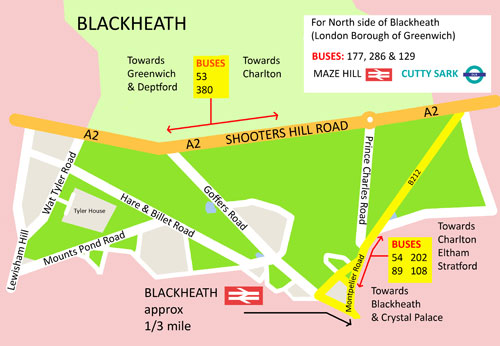Blackheath
Blackheath has a high vantage point beside the Thames, offering excellent views over London, Essex, Kent and Surrey.
The boundary between Lewisham and Greenwich is marked by the A2 trunk road which cuts through the heath.
Access
Facilities
Facilities include a tea hut and a football pitch.

Toilets
Temporary toilets are open everyday, 11am–8pm.
Ownership
The part of Blackheath south of the A2 is owned by the Lord of the Manor of Lewisham.
The part north of the A2 is owned by the Crown as part of the Royal Manor of East Greenwich.
Since 1871 it has been held in trust for public benefit through the Blackheath Supplement to the Metropolitan Commons Act of 1866.
Management
The Blackheath Joint Working Party is made up of:
-
Blackheath Society
-
The Greenwich Society
-
The Westcombe Society
-
representatives of Lewisham and Greenwich councils
They advise and act in relation to the management and maintenance of the heath. Decisions have to balance the needs of nature conservation, sports and recreation.
There is free public access at all times.
The history of Blackheath
A brief history of Blackheath from the period of ancient Roman civilisation to the Victorian era.
Origin of the name 'Blackheath'
The name "Blackheath" was recorded as early as the 11th century. It is often believed to come from its reputed use as a mass burial ground for victims of the Black Death in the 1340s but this is wrong. It probably comes from Old English words meaning 'dark soil', or that it is a corruption of 'bleak heath'. The latter seems the most likely.
War and rebellions
Blackheath is a place of strategic importance due to being an area of open, high ground just outside the City of London.
Because of this, the Romans first built their London to Dover road, known as Watling Street (now the A2), across it.
Since that time, the Heath has played host to more than its share of:
-
rebel gatherings
-
military encampments and exercises
-
royal meetings
-
religious festivals
-
sports
-
fairs
-
circuses
and a host of other activities.
This includes the events listed below:
-
Danish invaders camped here in 1011
-
during the Peasants' Revolt, Wat Tyler's 100,000 anti-poll tax rebels gathered here in 1381 before marching on London, where they were defeated
-
in 1450, Jack Cade led 20,000 Kent and Essex yeomen on to the Heath, where they set up camp in opposition to higher taxes being imposed by Henry VI - after fleeing to Sussex, Cade was eventually caught by the King’s forces and murdered
-
a later rebellion, of Cornishmen angry at being taxed for Scottish wars was suppressed in the Battle of Blackheath Field in 1497 (the only battle actually fought on Blackheath) - over 2,000 of the slain are reputedly buried in and around Blackheath, and Whitefield Mount is presumed to be their main place of burial
-
the heath has also been used as a marshalling area for British armies waiting to be shipped to fight abroad, particularly during the Napoleonic Wars, for military training and for parades
Peaceful gatherings
The heath was a favourite place for Lord Mayors of London to welcome their monarchs, from Richard II to Elizabeth I, and for royalty to meet distinguished guests:
-
Henry IV met the Emperor of Byzantium here in 1400.
-
Charles II met the welcoming citizens of London on Blackheath at the Restoration
John Wesley preached Methodism from Whitefield Mount, and Gladstone held election meetings there in the second half of the 19th century.
Highwaymen
Less welcome visitors were the highwaymen who frequented Blackheath, particularly in the 17th and 18th centuries.
A newspaper report of October 1735 noted that: 'We hear that for about six weeks past, Blackheath has been so infested by two highwaymen (supposed to be Rowden and Turpin) that 'tis dangerous for travellers to pass.'
Sport
Blackheath has a rich sporting history and to this day is home to a wide range of sports.
History of sport on Blackheath
Blackheath has an honourable place in the histories of many sports. England's oldest golf, rugby and hockey clubs were founded here.
Golfing history
According to legend, Blackheath Golf Club was established by James I in 1608, although the first evidence of what was then known as the Society of Goffers dates from the mid-18th century.
The Royal Blackheath Golf Club played on Blackheath until 1923, when it moved to its present home in Eltham.
Golf is now banned on the heath, but the association with the game is commemorated in the name of Goffers Road.
Turf
Most of the sports played today require very short turf on which to play, therefore for many years the grass has remain close-mown.
The exception to this occurred when the Second World War saw parts of the heath ploughed to produce food. It was also occupied by army Nissan huts.
In 1953 the last of the Nissan huts were finally removed and the heath was levelled and re-seeded.
Sport on the heath today
Sports currently played on the heath include:
-
hockey
-
rugby
-
football
-
cricket
-
lacrosse
-
athletics
-
baseball
-
American football
The heath is also well known as the starting point for the London Marathon.
Awards
- Green Flag award